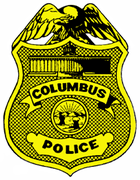Columbus Division of Police
| Columbus Division of Police | |
|---|---|
 | |
 | |
 | |
| Common name | Columbus Police |
| Abbreviation | CPD |
| Motto | Professionalism, Respect, Integrity, Discipline, Enthusiasm |
| Agency overview | |
| Formed | 1816 |
| Employees | 2,264 |
| Jurisdictional structure | |
| Operations jurisdiction | Columbus, Ohio, USA |
| Size | 223.11 sq mi (577.9 km2) (2013) |
| Population | 842,528 (2016) |
| General nature | • Local civilian agency |
| Headquarters | Columbus, Ohio |
|
| |
| Police Officers | 1,848 (2016) |
| Civilians | 416 (2016) |
| Agency executive |
|
| Subdivisions |
List
|
| Facilities | |
| Precincts | 20 |
| Motorcycles | 31 |
| Police Boats | 5 |
| Helicopters | 5 |
| Canines | 10 |
| Horses | 10 |
| Website | |
| Columbus Police Website | |
The Columbus Division of Police is the main policing unit for the city of Columbus, Ohio United States. It is the largest police department in the state of Ohio, and among the 25 largest in the United States.[1][2] It is composed of 20 precincts, and the Chief of Police is Kimberley Jacobs. Columbus is ranked the 38th most dangerous city in the United States according to the 2009 City Crime Rate Rankings.[3] Special units of the Columbus Division of Police include a Helicopter Unit, Canine Unit, Mounted Unit, Community Response Teams, Marine Park Unit, and Special Weapons and Tactics (SWAT) Team.[4]
In 2003, there were 1,779 sworn police officers and 349 civilian staff. In 2016, the numbers rose to 1,848 sworn officers and 416 total civilian staff. The estimated total budget was $244,575,878 in 2009, which rose to $310,139,284 for 2016.[5]
In April 2012, Deputy Chief Kimberley Jacobs was named the 32nd chief in the Division's history, and the first female chief in the division.[6]
Structure

The Columbus Division of Police has a total of six subdivisions. The subdivisions include the Administrative, Investigative, Support Services, Patrol South, Patrol North, and Homeland Security. Each subdivision is commanded by a Deputy Chief. The nature of each task to be performed determines which subdivision has responsibility and authority. As of 2015, the department has 460 marked patrol vehicles, 410 unmarked vehicles, 31 motorcycles, 154 bicycles, 5 boats, 10 horses, 10 canines, and 5 helicopters.[5]
Rank Structure
Current rankings are as follows: (As of 2016)
| Chief of police | 1 | |
| Deputy Chief | 6 | |
| Commander | 17 | |
| Lieutenant | 54 | |
| Sergeant | 225 | |
| Police Officer | 1,545 | |

Administrative Subdivision
This Subivision's Deputy Chief is Michael Woods. The Administrative Subdivision includes the Fiscal Management Bureau, Human Resources Bureau, Professional Standards Bureau, and Training Bureau.
Investigative Subdivision
This Subdivision's Deputy Chief is Timothy Becker. The Investigative Subdivision includes the Crime Against Persons Bureau, Property Crimes Bureau, Narcotics Bureau, and Special Victims Bureau.
Support Services
This Subdivision's Deputy Chief is Gary Dunlap. The Support Services Subdivision includes the Forensics Bureau, Records Management Bureau, Support Operations Bureau, and Technical Services Bureau.
Patrol North Subdivision
This Subdivision's Deputy Chief is Thomas Quinlan. The Patrol North Subdivision includes Zone 1 Patrol (North) Zone 4 Patrol (North central), and the Strategic Response Bureau.
Patrol South Subdivision
This Subdivision's Deputy Chief is Richard Bash. The Patrol South Subdivision includes Zones 2 Patrol (Southeast), Zone 3 Patrol (West), and Zone 5 Patrol (Central).
Homeland Security Subdivision
This Subdivision's Deputy Chief is Kenneth Kuebler. The Homeland Security Subdivision includes the Communications Bureau, Special Services Bureau, and Traffic Bureau.
Marked vehicles


The Columbus Police standard marked patrol fleet consists largely of Ford Police Interceptor Utility,[7] Ford Police Interceptor,[8] and Ford Crown Victoria Police Interceptor models. The Ford E-350 and Ford Transit 250 are used as Prisoner Transport Vehicles (PTVs).
Marked Vehicles can be identified by the numbered "license" plates. Two, three and four digit plates show the precinct number followed by the car number. So a plate bearing the number 55 is precinct-5 car-5; where plate 190 is precinct-19 car-0. Vehicles outside the standard precinct structure, i.e. Freeway Patrol, and Motorcycle Patrol also follow this pattern, where their unit is given a unique "precinct" number. For example, Freeway Patrol cruisers start with 6. Community Liaison cruisers begin with 3. Marked vehicles with a four digit starting in "9" are "mid-watch" assignments with the same pattern for their respective precinct.
The letter "R" as a prefix to this system denotes a "relief car". Plate R-106 is used because the 10th precinct has a regular vehicle in maintenance or repair. The letters "S" and "L" stand for Sergeant and Lieutenant, and denote that vehicle assigned to that ranked officer assigned to the following numbered precinct or zone: S-12 is the Sergeant for Precinct-12 and L-1 is the Lieutenant for Zone-1. The letter "T" Denotes a "Training" vehicle assigned to the Police Academy. The letter "X" stands for "eXtra"; X-Cars are kept at the city fleet management facility and are available to officers for special duty. "R" and "X" cars are, usually, re-numbered "retired" patrol cruisers in good condition.
In previous years, CPD utilized the Chevrolet Impala, Chevrolet Tahoe, Chevrolet Caprice, Plymouth Gran Fury, and Ford LTD II as cruisers.
Equipment
Special Duty
Some police duties that are required by law or requested by the general public fall outside the realm of normal, everyday procedures. For example, Ohio Law requires that only a Law Enforcement Officer may close a public road, or a lane thereof, without establishing a legal, marked detour(for road closure), or using concrete barriers (for lane restrictions only). In the event of a short-term construction project, a law enforcement officer must be on site to legally close the area to traffic.[9]
Columbus Police are permitted to work "Special Duty" assignments, upon approval, while off duty. Special Duty assignments can include anything from closing highway lanes for short-term road construction, to directing traffic for events, escorting a funeral procession, or providing security for private businesses, such as banks or stores. Most special duty assignments are paid for by the organization requesting the officers presence. However, while on Special Duty, the officer works for the City of Columbus, regardless the posting, and can be called upon by On Duty personnel if needed.
See also
References
- ↑ Based upon the number of sworn law enforcement officers."About CPD". Columbus Division of Police. Retrieved 3 October 2012.
- ↑ "Local Police Departments, 2007" (PDF). U.S. Department of Justice. Retrieved 3 October 2012.
- ↑
- ↑ 2006 Annual Report
- 1 2
- ↑ "Deputy Chief Kim Jacobs Named Columbus Police Chief". WBNS-10TV. Retrieved 5 April 2012.
- ↑ "Ford Police Interceptor Website". Ford. Retrieved February 1, 2016.
- ↑ "Ford Police Interceptor Website". Ford. Retrieved February 1, 2016.
- ↑ Ohio Revised Code 4511.051